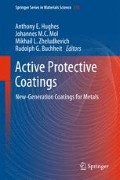Abstract
In the surface coatings industry, formulation is particularly important as it determines not only final properties and attributes of the coating but also the manner and ease with which a coating may be manufactured, applied and transformed into its final form. In this chapter, we consider the principles guiding formulation pertinent to the commercial production of coatings focussing on component selection, formulation and production. Its focus is to provide the reader with an appreciation of the practical complexity that may arise when producing a formulation, while reinforcing the notion that it is not simply a matter of adding one component to another. Ultimately the reader will be better equipped to understand and address the challenges involved in taking a self healing coating concept from laboratory scale to a higher level of technology readiness.
Access this chapter
Tax calculation will be finalised at checkout
Purchases are for personal use only
References
McCutcheon’s Emulsifiers & Detergents, McCutcheon Division, vol. 1 (MC Publishing Company, 2014)
The Raw Materials Index RMI, vol. RMI 8, (Surface Coating Association of Australia, 2008)
Colour Index International, http://www.colour-index.com/
G.B.A.G. Paff (ed.), Industrial Inorganic Pigments, 3rd edn. (Wiley, Germany, 2005)
Industrial Organic Pigments, 3rd edn. (Wiley, 2006)
High Performance Pigments, 2nd edn. Revised and Expanded (Wiley, 2009)
A. Ostman, Reducing the use of Dangerous Glycol Ethers (Nordic Council of Ministers, Chemical Group, Copenhagen, 1993)
B.K. Blaiszik, S.L.B. Olugebefola, S.C. Moore, J.S. Sottos, N.R. White, Self Healing Polymers and Composites, in Annual Review of Materials Research (Annual Reviews, USA, 2010) p. 32
A. Szegvari, M. Yang, in Seminar on Dispersion of Pigments and Resins in Fluid Media. Attritor Grinding and Dispersing Equipment (Union Process, Kent State University, 1999), p. 7
S. Hochberg, Process for Dispersing Pigments in Film-Forming Materials (Du Pont, USA, 1952)
K. Engels, Stirring Mill (Draiswerke Gmbh, USA, 1978)
H. Herman, H.Z. Hockmeyer, Basket Media Mill with Stirring Rods and Counterpart Stators, in US Patents Office, USPTO ed. (Hockmeyer Equipment Corp., USA, 1998), p. 9
S.X. Jinli Zhang, L. Wei, High shear mixers: a review of typical applications and studies on power draw, flow pattern, energy dissipation and transfer properties. Chem. Eng. Process. 57–58, 16 (2012)
K. Robin, J.L.K. Connelly, 3D numerical simulation of the flow of viscous newtonian and shear thinning fluids in a twin sigma blade mixer. Adv. Polym. Technol. 25(3), 12 (2006)
Fineness of Grind Gauges, http://www.gardco.com/pages/dispersion/fg/finenessofgrind.cfm
B. Hansen, Solubility Parameters for Film Formers. Official Digest of Federation of Society of Paint Technoogy (the former name of J. Coat. Technol. Res.), 27(369), 32 (1972)
C.M. Hansen, Hansen Solubility Parameters: A User’s Handbook, 2nd edn. (CRC Press, 2007), p. 544
D.A.B. Ward, Orientation of surfactants adsorbed on a hydrophobic surface. J. Phys. Chem 97, 2 (1993)
Fisher, R.A., The Design of Experiments (Macmillan Pub Co., 1971)
E.P. George, J.S.H. Box, G. William, Hunter Statistics for Experimenters: Design, Innovation, and Discovery, 2nd edn. Probability and Statistics (Wiley, 2005)
D.C.W. Abdullah Ekin, J.W. Daniels, S.J. Stafslien, F. Cassé, A. James, M.E. Callow, Callow, Synthesis, formulation, and characterization of siloxane–polyurethane coatings for underwater marine applications using combinatorial high-throughput experimentation. J. Coat. Technol. Res. 4(4), 6 (2007)
L.R.R.A. Price, X.H. Li et al., Investigation of the effects of formulation on selected properties of UV curable IPN coatings. J. Coat. Technol. Res. 70(885), 5 (1996)
Author information
Authors and Affiliations
Corresponding author
Editor information
Editors and Affiliations
Rights and permissions
Copyright information
© 2016 Springer Science+Business Media Dordrecht
About this chapter
Cite this chapter
Harris, D., Casey, P. (2016). Formulating Surface Coatings. In: Hughes, A., Mol, J., Zheludkevich, M., Buchheit, R. (eds) Active Protective Coatings. Springer Series in Materials Science, vol 233. Springer, Dordrecht. https://doi.org/10.1007/978-94-017-7540-3_5
Download citation
DOI: https://doi.org/10.1007/978-94-017-7540-3_5
Published:
Publisher Name: Springer, Dordrecht
Print ISBN: 978-94-017-7538-0
Online ISBN: 978-94-017-7540-3
eBook Packages: Chemistry and Materials ScienceChemistry and Material Science (R0)

